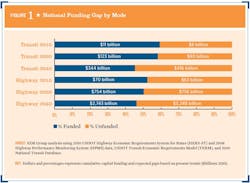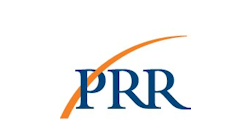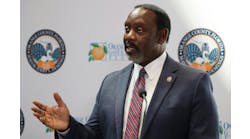Recently, a few of my colleagues and I headed to the streets of downtown Seattle to prove a theory that most people don’t really know how transportation — “their roads” — are paid for. When asked the question, some replied, “taxes.” When asked what kind of taxes, they paused, saying “road taxes?” or “I’m not sure.” The gas tax is an invisible tax. Generally, people don’t know what they pay in gas taxes, or that there’s a state and federal gas tax. But most value their transportation network and want it there when they need it. So when decision-makers put forth new, better or more fair ways to offset gas tax revenue, it’s challenging to get the public’s support for a solution to a problem they didn’t even know they had.
Transportation is there when we need it — we can hop in a car or take transit to most anywhere we need to go. Transportation provides the backbone to our economy and the main source of funding for these vital services, structures and systems is the gas tax.
Gas tax revenue represents about 85 percent of all federal revenues. In addition, each state collects its own gas tax and other fees including licensing and registration. Thirty states have addressed (and increased) transportation funding since 2012. The federal government has not raised its gas tax since 1993.
This method of collecting federal and state gas tax revenue generates funding to a certain level, but not nearly enough to pay for all of our transportation needs. In their 2017 Infrastructure Report Card, the American Society of Civil Engineers states that we have a $2 trillion 10-year investment gap in our national transportation funding.
Why aren’t we collecting enough revenue from the gas tax?
Gas taxes are based on a 20th century theory that gas purchases equal road use. Until hybrids and electric vehicles came on the scene, vehicles and their fuel efficiency did not vary significantly. More people are driving, and will drive, fuel-efficient vehicles, leading to less consumption of fuel and less collection of gas tax, which funds transportation. Vehicles have changed, technology has changed, but transportation funding has not.
Why people are driving more fuel-efficient vehicles: The Environmental Protection Agency and the National Highway Traffic Safety Association have issued federal standards to help reduce greenhouse gas (GHG) emissions and improve fuel economy for cars in model years 2017 through 2025. NTTSA developed Corporate Average Fuel Economy (CAFÉ) standards and EPA established national GHG emissions standards under the Clean Air Act. If these standards are achieved exclusively through fuel economy improvements, all vehicles built in model year 2017-2025 will have to get 54.5 miles per gallon by 2025. As of 2017, the EPA is reporting that automakers are on track to meet these ambitious government standards by 2025.
Why people are driving less: We’ve all heard that millennials are not driving as much, don’t want to invest in a vehicle, and are using other modes like rideshare or transit. There’s data to prove that theory and data to disprove it. Most studies align on a few tenets:
- Young people are not getting driver’s licenses so much anymore — no one is. A new study at the University of Michigan Transportation Research Institute reports: “the percentage of people with a driver’s license decreased between 2011 and 2014, across all age groups. The top three reasons reported were: “too busy or not enough time to get a driver’s license” (37 percent), “owning and maintaining a vehicle is too expensive” (32 percent), and “able to get transportation from others” (31 percent).” In addition, more people are living in cities and using public transit. In the Michigan study, 17 percent stated their reason for not getting a driver’s license as preferring public transit.
- There are more options besides driving alone in your own vehicle. Public transit is better than ever. In fact, when given the opportunity in 2017, voters nationwide approved 34 of 49 local transit ballot measures at a historic funding level of $170 billion to improve transit even more. Today, we have reliable ridesharing services like Uber and Lyft. We can share a vehicle through car2go, ReachNow and Zipcar.
We have new solutions to address this funding problem
Public-Private Partnerships: States like Virginia, Florida, Colorado, Pennsylvania and others are turning to the P3 model to deliver large transportation projects such as roads, bridges, transit systems and toll facilities. P3s allow for the private industry to partner with public agencies to invest in funding transportation, leveraging tolls and other fees to pay back the investment with interest. Maryland Governor Larry Hogan is the latest of many state leaders turning to this innovative approach, announcing the state would rely on $9 billion in P3s to add miles of toll lanes to the Beltway, Interstate 270 and the Baltimore-Washington Parkway.
Tolling: Based on the user-pays principle, tolling our nation’s roadways, bridges and tunnels has proven to be a successful way to fund transportation. The International Bridge, Tunnel and Turnpike Association reports “not only are more people traveling on our roads and bridges, but toll road use has increased significantly. Clearly, drivers recognize the benefits of toll roads — the ease of use provided by electronic payment methods, the trip time-saving benefits and the improved safety that a well-maintained toll facility provides.”
Road Usage Charging: Many states across the nation are looking into the possibility of charging drivers by the mile rather than by the gallon to fund transportation. Oregon was the first state in the nation to pioneer the road usage charge concept through their innovative new program, OReGO. In their April 2017 Final Report, the Oregon Department of Transportation reported “the most important learning of the OReGO test program is that the system works: charging drivers by the mile instead of gallon consumed is possible.”
So we have solutions. How do we get people to understand the problem and change the way they pay for transportation?
Before we can expect people’s behaviors to change, people need to know that there is a problem to solve. Once they are aware and understand the problem, they need to understand the solution(s). Once a level of understanding is in place, people can accept the overall situation and take action. People can begin trying one of the solutions mentioned above. After that, it is all about maintenance. But that first crucial step, is awareness.
When states sponsor transportation projects or campaigns, awareness around the need for transportation funding is raised. Before Oregon launched their OReGO road usage charge system, they tested the concept and laid the groundwork with the public for 12 years. Their research shows that awareness raises each year, yet 64 percent of those surveyed a year after the OReGO launch did not know they were paying 49 cents per gallon in gas tax. One in 10 (11 percent) were entirely unaware that they were paying a gas tax at all.
Raising awareness of the need for alternative sources of transportation funding will take a national movement.
A national education campaign on the funding crisis and the need for a new way to fund transportation would mean strong messages, data and communications tools that could be integrated into toll projects, P3s, and road usage charging programs.
Colleen Gants is the co-president of PRR Inc.


